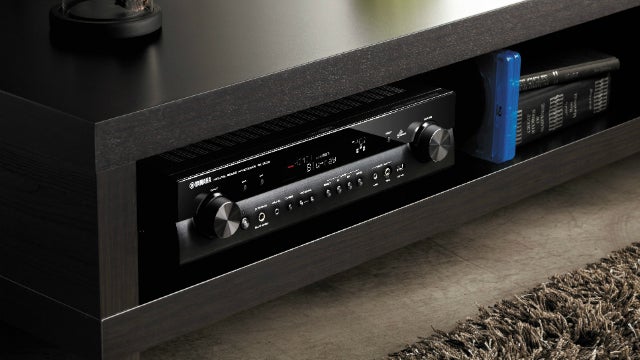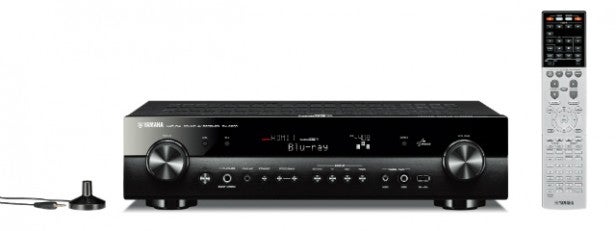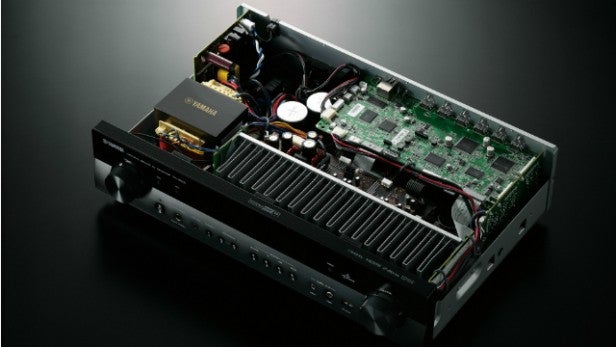Yamaha RX-S600 Review
Yamaha RX-S600
Yamaha’s low-profile AV receiver boasts AirPlay, Spotify, DLNA and looks the business

Sections
- Page 1 Yamaha RX-S600 Review
- Page 2 Features and Operation Review
- Page 3 Performance and Verdict Review
Verdict
Pros
- Slim design, easy to accommodate
- Generous network features and good spec
- Build quality
Cons
- Rudimentary onscreen menus
- Some rivals sound bigger and punchier
Key Specifications
- Review Price: £399.00
- Slim 111mm-high design
- 5 x 60W power output
- Dolby True HD & DTS HD Master Audio decoding
- DLNA file streaming
- AirPlay, Spotify, internet radio
What is the Yamaha RX-S600?
Most home cinema receivers are big, back-breaking boxes that gobble up space in your AV rack, but not so the Yamaha RX-S600 – its slim, sleek bodywork is much easier to accommodate. But just because the casing has been slimmed down, that doesn’t mean the feature list has too. The RX-S600 boasts most of the technology found on Yamaha’s latest full-size receivers, including AirPlay, DLNA and online music streaming. And at around £400, the price tag is pretty slim too, making it an appealing proposition on paper.

Yamaha RX-S600 – Design and Connections
Despite its compact casing, the RX-S600 still looks like a typical Yamaha receiver. The customary clean lines and sleek black finish are all present and correct (it’s also available in Titanium) while the front panel buttons, lights and dials give it a busy, hi-tech appearance. It’s attractive, if not particularly subtle.
The fascia is split into two horizontal halves – the top half boasts a large, bright dot matrix LED panel (showing the selected input when idle), which can be dimmed in the setup menu. The lower half houses USB, composite video and 3.5mm minijack inputs, as well as headphone output and a port for the YPAO audio setup mic.
Among the buttons are four ‘Scene’ keys, each labelled with a different source. They turn on the relevant component, select the correct DSP setting and start playback.

The 111mm-high casing makes a huge difference when installing it next to other AV boxes in a rack or shelving unit – it’s barely an inch taller than an OPPO Blu-ray player. This is made possible by the RX-S600’s revamped ground and power supply pattern, plus custom-designed parts. Build quality is superb – it’s a strong, rigid box with a thick fascia fashioned from aluminium.
Naturally the slimmed-down rear panel means connectivity is far from comprehensive, but Yamaha has still provided a generous amount. There are five HDMI inputs, all of which can pass through AV signals (including 4K and 3D) even when the unit is in standby. It’s great to see that the HDMI 5 connection offers MHL support for hi-def video viewing from compatible smartphones, but it would have been more useful on the front.
Other inputs include two optical and two coaxial audio, three analogue stereo and composite video, two component video, Ethernet and an FM/AM aerial terminal.
As for outputs, you get one each of the following: HDMI (with ARC), analogue stereo, component video, composite video, subwoofer and a DC out for optional accessories. These include the YWA-10 Wi-FI adapter and YBA-11 Bluetooth audio receiver (neither feature is included as standard).
Five sturdy screw-type speaker terminals also adorn the rear. You can devote three channels to the main zone and send two to a second zone thanks to the Party Mode.

